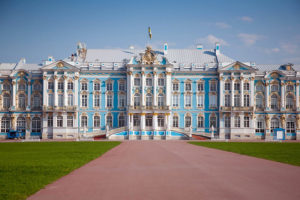 Catherine Palace is in Tsarskoye Selo city. It is 25 km from St. Petersburg, Russia. The palace is a place of rest for Catherine the Great during her journeys. The empress asked a designer to build the palace in 1717 for her summer residence. Catherine Palace had received some renovations since 1733. However, many people do not know about facts that lay behind the historical building.
Catherine Palace is in Tsarskoye Selo city. It is 25 km from St. Petersburg, Russia. The palace is a place of rest for Catherine the Great during her journeys. The empress asked a designer to build the palace in 1717 for her summer residence. Catherine Palace had received some renovations since 1733. However, many people do not know about facts that lay behind the historical building.
Here are 8 facts about Catherine Palace in Russia that you should know:
1. The palace is on “Tsarist” road
The choosing of Tsarist road as the place to build the building began in 1712. It was when Peter the Great moved Russian Capital from Moscow to St. Petersburg. Following the movement, the road between the two cities became the main route for governmental business. As the Tsars frequently used the road, towns and monasteries were built alongside it. In the second half of the 18th century, Catherine the Great asked workers to pave the road with stones. She also asked workers to build 1 grand travel lodge in every 40 miles along the road.
2. Catherine Palace is different from other palaces in term of architecture
Most of the travel lodges are not architecturally impressive. They mostly function as post offices and lodgings for imperial officials, members of court and other guests. However, it is different with Catherine Palace. The palace is a place for balls and receptions. In 1767, Catherine the Great stopped by the palace during her journey from St. Petersburg to Simbirsk. There were approximately 2000 people accompanied her, including Austrian, French and British ambassadors.
3. Tver’s bishop’s house once stood at the site before it burned down
In 1763, a fire occurred and burned down wooden Kremlin and other ancient buildings. Following the fire, major construction in Tver began. Catherine the Great asked architect Peter Nakitin, who created general plans for many provincial Russian towns, to mend the ruin. He went to Tver to restore the city by following new approach of city planning. After Nakitin finished all of his work, Catherine the Great remarked Tver as the second most beautiful city after St. Petersburg. Nakitin then designed the palace on the area where house of Tver’s bishop stood before.
4. Catherine Palace is designed by famous architects of the time
Catherine the Great hired several best architects to build the palace. She also asked them to renovate it. Matvey Kazakov was among architects who construct it. After assisting Nakiti, Kazakov went on building several building. Those building included Moscow University and Petroff Palace. Besides, Jean-Baptiste Vallin de la Mothe designed interior decoration for bedchamber and other rooms in the palace. At the beginning of the 19th century, Carlo Rossi and Joseph Bové reconstructed Catherine Palace. Rossi was the architect for the General Staff Building on Palace Square in St. Petersburg. Bové built Bolshoi Theatre. Moreover, Vladimir Borovikovsky painted the icons of the palace’s church.
5. The interiors looks like those of imperial palaces in St. Petersburg
Basically, Chaterine palace’s interiors were executed to suit grand buildings. The interiors included luxury textile wallpaper, Dutch ovens with tiles and parquet floors. There were also plaster columns, extravagant stucco-work and mirrors. Adding to the grand, there were wrought iron stairs, bronze chandeliers, paintings and sculptures. Many people recalled that the empress fell in love with Catherine Palace. Contemporaries also mentioned its luxurious decorations in their memoirs.
6. Catherine palace was a social center
In early the 19th century, function of Catherine palace changed. In addition to being the place of rest for emperors during their travels, it became the residence of the governor general of Tver Region. George Duke of Oldenburg and his wife Grand Duchess Ekaterina Pavlovna, sister of Emperor Alexander I, also rested in it. They also participated in remodeling the palace. At that time, the palace became one of the centers of Russia’s social life and a fashionable literary salon.
7. Restoration of Catherine Palace began in 2012
In 2012, restoration of Catherin Palace began. This was performed due to key elements of the decoration were lost. Moreover, many people stole objects in the palace during Soviet times. Now that the restoration has been done, the palace returned to its former luxury. Russian artist of Italian descent painted pictorial panel. Fyodor Bruni was put back on the grand staircase. Meanwhile, museum halls received Canaletto canvases that once decorated the palace.
In particular, the palace also managed to preserve its luxurious sets of furniture. The furniture included gilded sphinxes on the armrests and armchairs with swans. Carlo Rossi designed the sphinxes. Meanwhile, Andrey Voronikhin created the armchairs. Voronikhin also designed Kazan Cathedral in St. Petersburg.
8. Before Bolshevik revolution, Catherine Palace was a museum
The halls of Catherine Palace had been the place of Tver Regional Art Gallery for 50 years. However, it was already a museum prior to Bolshevik revolution. You may want to read more about revolution in Russia.
In 1894, an exhibition of St. Petersburg artists and Moscow was held in the palace. In 1896, the function of the palace changed into a public historical-archaeological museum. In 1960s, famous paintings were displayed in halls that had been restored after World War Two destroyed it. Those paintings included the creation of celebrated artists in 18th and 19th century, including Borovikovsky, Levitan, Korovin and Serov.
Those are 8 Facts about Catherine Palace in Russia. You might want to read more of history surrounding Russia.
